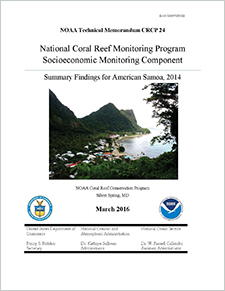-
Home
-
Data & Publications
-
Regional Portals
- About Regional Portals
- Florida
- Navassa Island
- Puerto Rico
- Flower Garden Banks
- U.S. Virgin Islands
- American Samoa
- Commonwealth of the Northern Mariana Islands
- Federated States of Micronesia
- Guam
- Main Hawaiian Islands
- Republic of the Marshall Islands
- Northwestern Hawaiian Islands
- Republic of Palau
- Pacific Remote Island Areas
-
CRCP Activities
- Glossary
National Coral Reef Monitoring Program Socioeconomic Monitoring Component. Summary Findings for American Samoa, 2014

The Socioeconomic Component of the National Coral Reef Monitoring Program (NCRMP) is currently in the process of monitoring socioeconomic indicators across all U.S. coral reef territories and jurisdictions. These indicators include the demographics of these areas, human use of coral reef resources, as well as knowledge, attitudes, and perceptions of coral reefs and coral reef management. The overall goal of this endeavor is to track relevant information regarding each jurisdiction's population, social and economic structure, society's interactions with coral reef resources, and the responses of local communities to coral management. NOAA's Coral Reef Conservation Program (CRCP) will use the information for research, to assess the socioeconomic outcomes of management activities, and to improve the results of programs designed to protect coral reef resources.
This report outlines human dimensions information relevant to coral reef resources in American Samoa. The findings here are derived from a combination of data gathered through household surveys conducted in February 2014, and additional secondary sources of socioeconomic information for the jurisdiction. Surveys demonstrated that participation in recreational coral reef related activities such as SCUBA diving and snorkeling is relatively uncommon in American Samoa, with the exception of swimming and beach recreation. However, over half of residents participate in fishing or gathering of marine resources. Residents of urban areas perceived coral reef ecosystem health to be in worse condition than residents of rural areas. Additionally, surveys revealed that American Samoans generally support current marine management policies and regulations, regardless of their reliance on marine resources, and are generally trusting of the government as a source of information.
Like several coral reef jurisdictions, the population of American Samoa declined between 2000 and 2010. The jurisdiction faces a number of social challenges. GDP has declined in American Samoa in recent years, and over half of the population has incomes below the poverty line. Infrastructure, particularly for the treatment of sewage and water, remains limited.
There were a few lessons learned from this first NCRMP socioeconomic data collection in American Samoa. As similar surveys are implemented across other U.S. coral reef jurisdictions, the NCRMP team will be making adjustments to the data collection effort to improve on the type of information being generated. These findings can be considered as a starting point to develop more detailed research questions for future work.
Citation: A. Levine, M. Dillard, J. Loerzel and P. Edwards. 2016. National Coral Reef Monitoring Program Socioeconomic Monitoring Component. Summary Findings for American Samoa, 2014. Silver Spring, MD: NOAA Coral Reef Conservation Program. NOAA Technical Memorandum CRCP 24. 80 pp. DOI: 10.7289/V5FB50Z1


